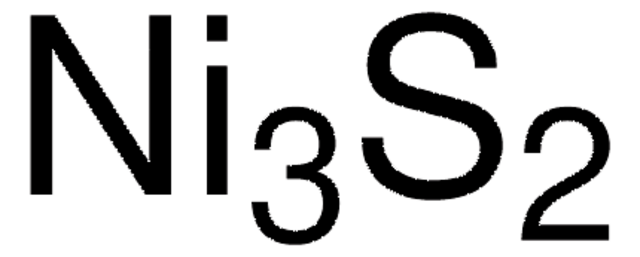656895
Nickel(II) sulfate
anhydrous, 99.99% trace metals basis
Sinónimos:
Nickel(2+) sulfate, Nickelous sulfate
About This Item
Productos recomendados
grado
anhydrous
Análisis
99.99% trace metals basis
formulario
solid
impurezas
≤150.0 ppm Trace Metal Analysis
aplicaciones
battery manufacturing
cadena SMILES
[Ni++].[O-]S([O-])(=O)=O
InChI
1S/Ni.H2O4S/c;1-5(2,3)4/h;(H2,1,2,3,4)/q+2;/p-2
Clave InChI
LGQLOGILCSXPEA-UHFFFAOYSA-L
Descripción general
Properties of NiSO4:
- Highly soluble in water
- It can participate in redox reactions
- It can form complexes with various ligands
Aplicación
- Nickel-based electrocatalysts for oxygen evolution.
- Ni-doped titanium dioxide nanoparticles for the photocatalytic degradation of organic pollutants such as methyl orange.
- Spherical silica particles coated with Ni, which find application in the field of ceramic industry and in catalysis.
Para utilizar con
Palabra de señalización
Danger
Frases de peligro
Consejos de prudencia
Clasificaciones de peligro
Acute Tox. 4 Inhalation - Acute Tox. 4 Oral - Aquatic Chronic 1 - Carc. 1A Inhalation - Muta. 2 - Repr. 1B - Resp. Sens. 1 - Skin Irrit. 2 - Skin Sens. 1 - STOT RE 1 Inhalation
Órganos de actuación
respiratory tract irritation
Código de clase de almacenamiento
6.1C - Combustible acute toxic Cat.3 / toxic compounds or compounds which causing chronic effects
Clase de riesgo para el agua (WGK)
WGK 3
Punto de inflamabilidad (°F)
Not applicable
Punto de inflamabilidad (°C)
Not applicable
Equipo de protección personal
Eyeshields, Faceshields, Gloves, type P3 (EN 143) respirator cartridges
Elija entre una de las versiones más recientes:
¿Ya tiene este producto?
Encuentre la documentación para los productos que ha comprado recientemente en la Biblioteca de documentos.
Los clientes también vieron
Artículos
In many technologies, performance requirements drive device dimensions below the scale of electron mean free paths (λe). This trend has increased scientific interest and technological importance of electrical resistivities at the nanoscale.
Lithium-Ion Battery Performance: Dependence on Material Synthesis and Post‑Treatment Methods
Plasmonic nanoparticles have unique optical properties that can be tailored to suit a variety of applications in the biotechnology1–8 and electronics9–16 industries.
Nuestro equipo de científicos tiene experiencia en todas las áreas de investigación: Ciencias de la vida, Ciencia de los materiales, Síntesis química, Cromatografía, Analítica y muchas otras.
Póngase en contacto con el Servicio técnico













